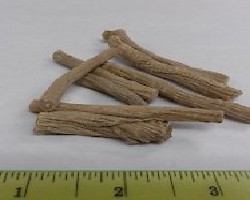Huai Niu Xi - Achyranthes Root
TCM Materia Medica
Huai Niu Xi TCM Herb Classifications and Usages
The TCM herb "huai niu xi" which in english is  "achyranthes root", is categorized within the "herbs that invigorate blood" functional grouping. It is thought to enter the kidney and liver channels and exhibits bitter (ku), neutral (ping) and sour (suan) taste/temperature properties.
"achyranthes root", is categorized within the "herbs that invigorate blood" functional grouping. It is thought to enter the kidney and liver channels and exhibits bitter (ku), neutral (ping) and sour (suan) taste/temperature properties.
Dosages and preparations will vary according to each individual and the overall approach of a formula, but generally this herb has the following dosage and/or preparation guidelines:
- Dosage: 9-15g
Of many possible clinical applications, it may be considered to influence the following issues/symptoms:
- Invigorates blood, expels blood stasis - dysmenorrhea, amenorrhea, lochioschesis.
- Strengthens the sinews, bones, and joints - lower back and knee issues due to deficiency (tonifies the liver and kidneys).
- Clears damp heat in the lower burner - damp-heat pouring downward manifesting as back and knee pain, w/lin.
- Brings blood downward - yin deficiency with fire or hot blood in the upper warmer, vomiting blood, toothache, nosebleed, dizziness, headache, blurred vision (yang rising).
Huai Niu Xi has some precautions to be considered (see our precautions list).
- Avoid During Pregnancy
Huai Niu Xi may potentially be used, in coordination with a well tailored formula (in most cases), to influence the following conditions: amenorrhea (absence of menstruation), back pain, dizziness (vertigo), dysmenorrhea (menstrual pain - cramps), headache, knee pain, toothache, vision problems and/or vomiting
While it may not always be included depending on the manufacturer or herbalist making the formula, huai niu xi is generally included in the following 4 formulas:
ViewDan Shen Huo Xue Wan (Red Sage Root Decoction for Promoting Blood Circulation)
Phlebitis, generally chronic.
ViewJiang Ya Wan (Repress The Blood Pressure Pills)
Hypertension particularly with ascendent yang and heat signs - red face, red tongue, headaches, irritability, anxiety, insomnia, etc.
ViewShu Jing Huo Xue Wan (Relax The Channels and Invigorate The Blood Decoction)
Primarily used for blood stasis with wind-damp in the channels and collaterals characterized by internal deficiency with external excesses - joint pain, muscle aches, numbness and/or pain in the lowe…
ViewSi Miao Wan (Four Marvels Powder)
Damp-Heat Bi-Syndromes in Chinese Medicine terms - arthritis with hot swollen joints. With the right underlying diagnosis both osteo-arthritis and rheumatoid arthritis would respond. Gout. Weakness…
As noted above, huai niu xi is within the herbs that invigorate blood functional group. All the herbs in this category are listed below.
(truncated intro "... for blood stasis - pain, abscesses and ulcers, abdominal masses. )".
All Content 1999-2025
Chad J. Dupuis / Yin Yang House
Our Policies and Privacy Guidelines
Our Affiliated Clinics
